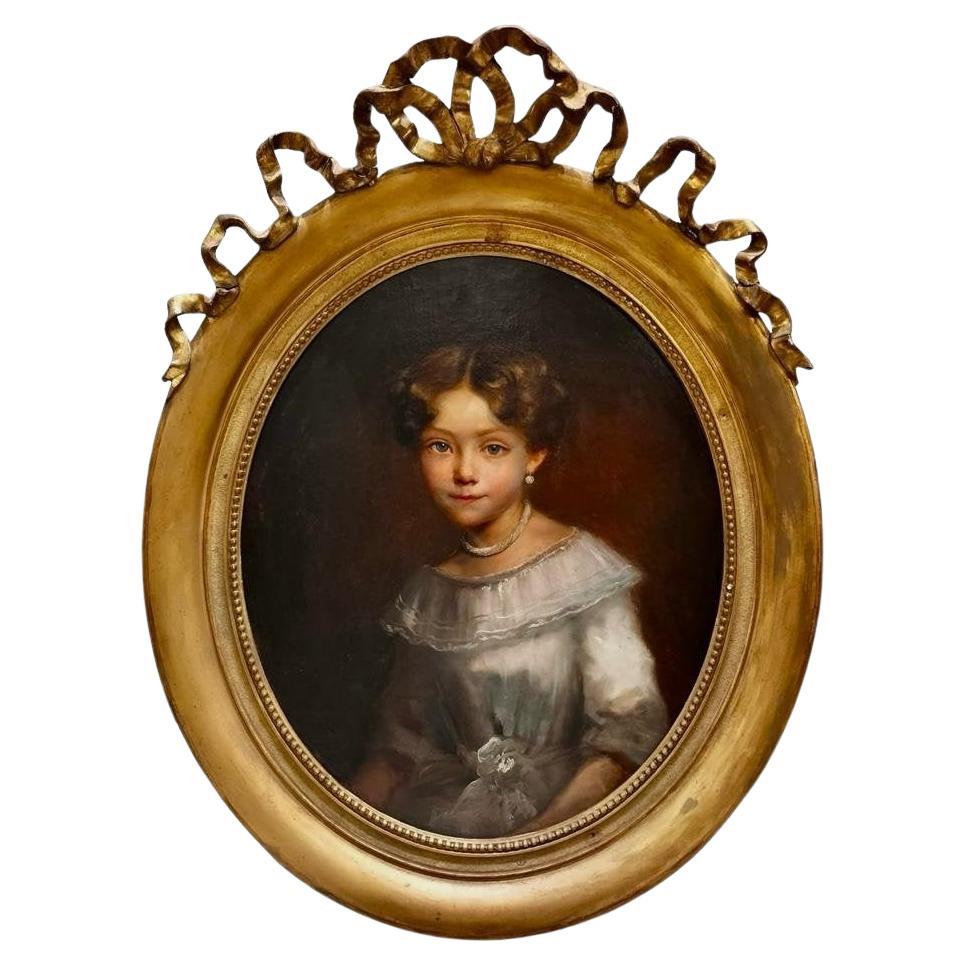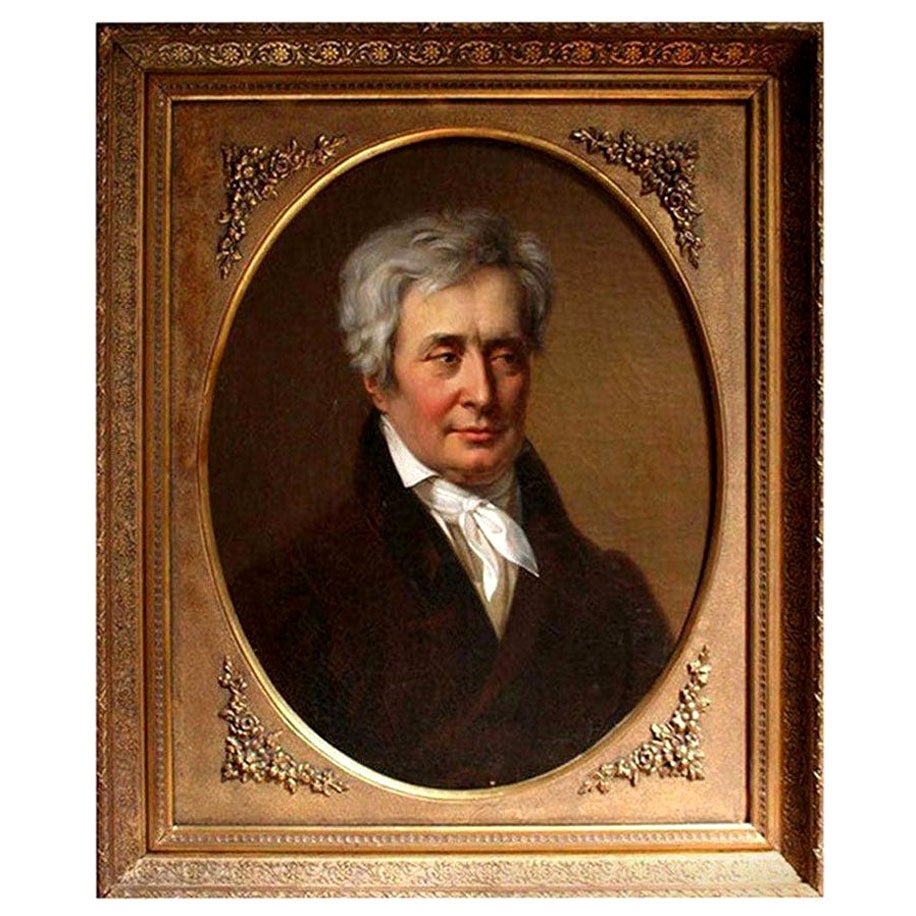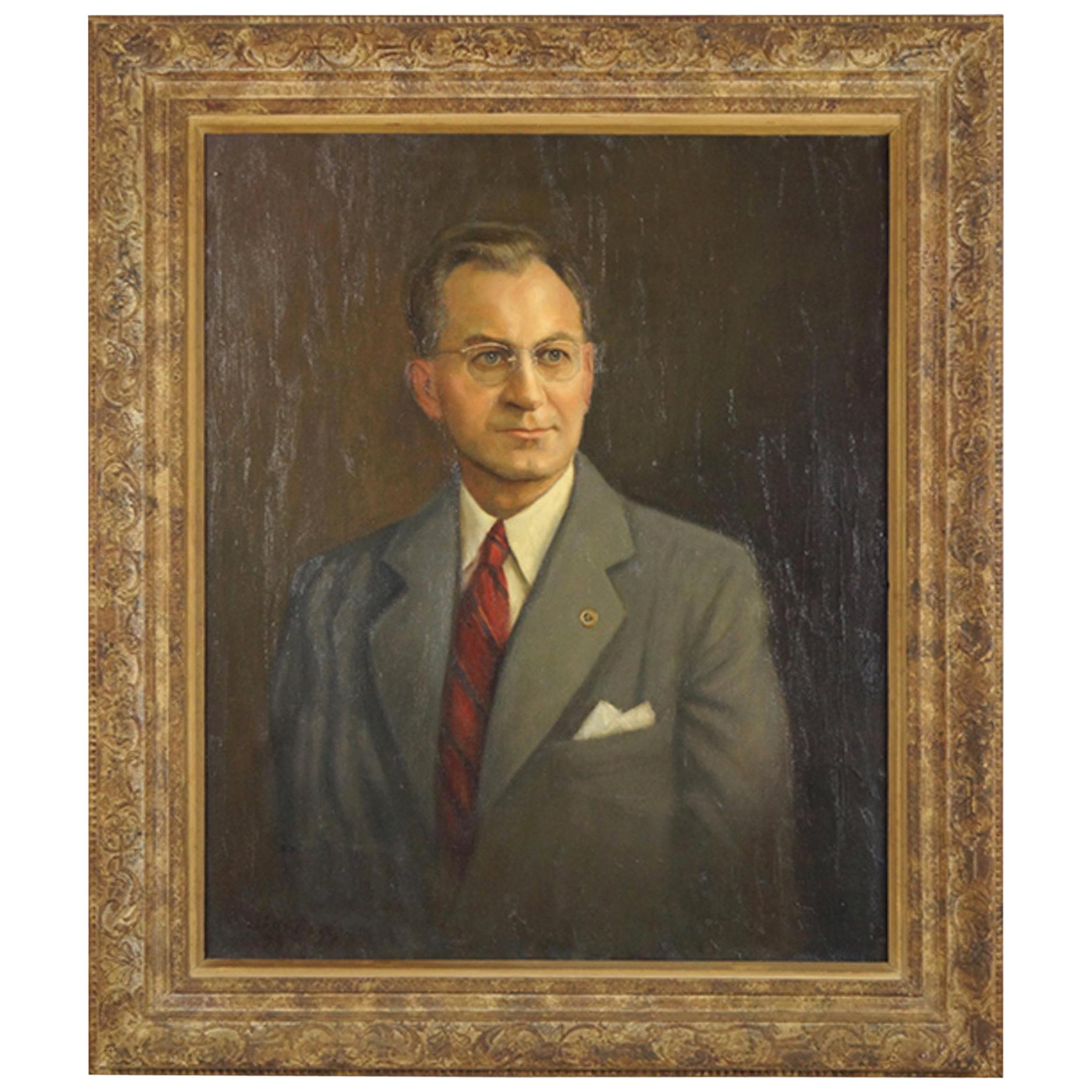Items Similar to Portrait of Lars Gathenhielm '1689-1718' in Gilded Worked Frame
Want more images or videos?
Request additional images or videos from the seller
1 of 10
Portrait of Lars Gathenhielm '1689-1718' in Gilded Worked Frame
About the Item
European workshop XVII century
Portrait of Lars Gathenhielm (1689-1718)
Oil on canvas
Unsigned
Lars Gathenhielm (1689–1718), was a Swedish sea captain, commander, shipowner merchant, and privateer.
To protect Swedish shipping from pirates and to harm the enemy, in June 1710 the government of King Charles XII of Sweden gave Lars Gathenhielm granting permission to seize ships from enemy nations including Denmark and Russia. His vessels captured foreign merchant vessels and forced them into port where both cargo and ships were sold.
His name and character appears in several literary works and chimeras, by authors such as Verner von Heidenstam and Selma Lagerlöf.
- Dimensions:Height: 36.23 in (92 cm)Diameter: 28.35 in (72 cm)
- Style:Rococo (Of the Period)
- Materials and Techniques:
- Place of Origin:
- Period:Late 17th Century
- Date of Manufacture:17th Century
- Condition:Wear consistent with age and use.
- Seller Location:Lisboa, PT
- Reference Number:1stDibs: LU7365234503622
About the Seller
5.0
Vetted Seller
These experienced sellers undergo a comprehensive evaluation by our team of in-house experts.
Established in 2018
1stDibs seller since 2022
10 sales on 1stDibs
- ShippingRetrieving quote...Ships From: Lisboa, Portugal
- Return PolicyA return for this item may be initiated within 14 days of delivery.
More From This SellerView All
- Portrait of D. Maria Bárbara De Bragança, Circle of Louis-Michel Van LooBy H. van LoonLocated in Lisboa, PTPORTRAIT OF D. MARIA BÁRBARA DE BRAGANÇA (1711-1758), QUEEN OF SPAIN Circle of Louis-Michel van Loo (1707-1771) Oil on canvas Her Royal Highness, the Infanta Maria Barbara of Braganza (1711-1758) was the first-born child of King John V of Portugal (1689-1750) and his queen consort Maria Anna of Austria (1683-1754). Born in December 1711, she had the Convent Palace of Mafra built in her honour following a vow made by her royal father. Her status as Princess of Brazil, inherent to 18th century Portuguese presumptive heirs, would however be superseded once the queen gave birth to two male princes, D. Pedro (1712-1714) and D. José (1714-1777), preventing her from ascending to the throne. Daughter of one of the most illustrious monarchs of his time, Maria Barbara was carefully educated to become a fond admirer of the arts, and of music in particular, having had the Italian composer Domenico Scarlatti (1685-1757) as her music teacher. On the 10th January 1723 the young princess was betrothed to the Infante Ferdinand of Spain (1713-1759), eldest son of King Philip V (1683-1746). Six years later, on the 19th January, she entered her new country in a carefully choreographed ceremony that became known to history as the “Exchange of the Princesses”. This unique event took place on a specially built Bridge-Palace, a wooden, luxuriously decorated structure that included various modules and rooms, on both banks of the river Caia, the natural border between the town of Elvas in Portugal and of Badajoz in Spain. Simultaneously, on the same day that the Portuguese Infanta crossed the border to marry the Spanish Crown Prince, her new sister in law, the Infanta Mariana Victoria of Bourbon (1718-1781), her husband’s sister, crossed the same bridge in the opposite direction to marry Prince D. José, the Portuguese heir to the throne. Once married, Maria Barbara would spend 17 years as Princess of Asturias, only becoming Queen of Spain at her husband’s accession following the death of Philip V in 1746. She is portrayed in the 1743 painting by Louis-Michel van Loo (1707-1771) now in the Prado Museum, in which Philip V had himself represented with all his close family. The new Queen would take an important role at court eventually becoming the liaison between her husband and the King of Portugal, particularly throughout the negotiations for the Treaty of Madrid (1746-1750). Maintaining her interest in music, she patronized the Italian castrato singer Farinelli (1705-1782) while remaining close to her old master Scarlatti, having herself composed some sonatas for a large orchestra. She would also commission and fund the building of the Royal Salesians Monastery complex in central Madrid, where both her and Ferdinand VI are buried. The portrait we are presenting for sale shows the Queen in half-length, turning left at three quarters. She is wearing a blue low-cut dress embroidered with flowers and foliage, over a lace cuffed white blouse, and an ermine cloak pined on the left-hand side by a diamond broach. The powdered hair style is held sideways by a seven diamond and black plume headdress and topped by a small gold and pearl crown. The right arm rests on a cushion while the left hand, at chest height, holds a miniature male portrait. The Infanta’s features are analogous to the 1725 portrait by the painter Domenico Duprà (1689-1770), also in the Prado Museum collection. Further similarities can be found in another portrait by Louis-Michel van Loo, in which a seven diamond and black plume headdress is also present. In this work, the cushion supporting Maria Barbara’s right arm has also some obvious similarities to our painting. The same diamond headdress reappears in Van Loo’s above-mentioned portrait of Philip V’s family dated from 1743. It is nevertheless in Lisbon’s Ajuda National Palace that it is possible to find an almost identical depiction of the Infanta holding a miniature portrait of her husband. In it, the future Ferdinand VI is portrayed facing right at three quarters and wearing a curly wig, suit of armour, the golden fleece insignia and a blue band, in a composition that closely resembles an 18th century Spanish school painting that appeared in the art market in January 2016. Another detail common to various portraits of the Portuguese Infanta and Queen of Spain is the small gold and pearl crown on her head. In another Van Loo painting, also from the Prado Museum, in which Maria Barbara is portrayed as Queen, this crown is represented together with a headdress similar to the one previously described. Another two paintings by the same artist, at the Royal Academy of Saint Ferdinand, include the same ornament. We must also refer the paintings by the artist Jean Ranc (1674-1735). In one, dating from 1729 (Prado Museum), the Infanta is depicted outdoors holding a flower bouquet and wearing a yellow silk dress with red cloak, and a set of diamond and ruby jewellery that includes a headdress similar to the one present in our portrait. Another work by the same artist, belonging to the Complutence University of Madrid, depicts the Infanta sumptuously dressed in identical colours to our painting and wearing an elaborate headdress and diadem. These portraits, beyond their iconographical importance as contemporary records of the Infanta and Queen Maria Barbara, are also illustrative of 18th century fashion for jewelled head dressing. Often, flowers were combined with joyful adornments, composing almost theatrical displays that would reinforce the ostentatious nature of the image. The ornamental flowers and the chromatic character of the jewels would complement the luxury of the colourful dresses in blue, crimson, green or other silk shades, in compositions whose sole purpose was to highlight a royal sitter’s wealth and power, becoming an essential statement accessory within the strict court protocols and codes of conduct. Circle of Louis-Michel van Loo (1707-1771) Slowly but steadily, the resolute, tranquil and dignified attitude of Renaissance and Baroque portraiture becomes artificial and presumptuous. Mid 18th century society favours elusive expression and psychological deepness, albeit limited to the face, that, with emphasis on detail, on the rich colour palette and on changing costumes and landscapes, associated to the courtliness of gestures, creates a strongly artificial environment while maintaining a highly poetic intrinsic character. Louis-Michel van Loo followed a dynasty of famous Dutch origin artists that had settled in France. Initially taught by his father, Jean-Baptiste von Loo (1684-1745), the younger van Loo studied in Turin and Rome and frequented the Paris Academy. In Rome he worked with his uncle Charles-André van Loo (1705-1765) and become a painter for the Turin Court. In 1737 he arrived in Spain being summoned by Philip V to succeed Jean Ranc as painter of the king’s chamber. In Madrid, his work covers the numerous Court commissions and the Royal Saint Ferdinand Fine Arts Academy, of which he was a founding member and director for the Painting department in 1752. Is production at court consisted essentially of numerous portrait paintings, often Royal gifts...Category
Antique 18th Century Spanish Baroque Paintings
MaterialsCanvas
- Adoration of the Shepherds, French School, Oil on Canvas, 18th Century, FramedLocated in Lisboa, PTAdoration of the Shepherds, French School. Oil on canvas, 18th Century. Framed.Category
Antique 18th Century French Paintings
MaterialsPaint
- XX Century Wall Decoration in Style of PompeiiLocated in Lisboa, PTThe ancient city of Pompeii was founded sometime around the 7th or 6th century BCE by the Oscans, an Italic tribe that inhabited the region of Campania in what is now southern Italy....Category
Mid-20th Century European Paintings
MaterialsCanvas
- Boat port in Oil on WoodLocated in Lisboa, PTBoat port, oil on wood. Not signed. From France.Category
Antique Late 19th Century French Paintings
MaterialsOak
- Dogs in Oil on Canvas, France, 1890/1893Located in Lisboa, PTDogs in oil on canvas - France 1890/1893. Signed E. Clement.Category
Antique 19th Century French Paintings
MaterialsCanvas
- Judgment of Solomon Painting under GlassLocated in Lisboa, PTThe Judgment of Solomon painting under glass according to an original drawing by Nicolas Poussin, dated 1649, in the Louvre Museum, Paris. Portu...Category
Antique 18th Century Portuguese Paintings
MaterialsGlass, Oak
You May Also Like
- Portrait of Gentleman, Oil on Canvas, Gilded FrameLocated in San Francisco, CASmall framed oil painting of an unknown 19th Century gentleman, of the same timeframe. Painting is in good condition, considering its age. Unsigned.Category
Antique 19th Century American American Classical Paintings
MaterialsCanvas, Wood
- 19th Century Oval Portrait of Aristocrat Girl in Gilded FrameLocated in NICE, FRWe present you with this unique oval portrait painting rendered in oil on canvas. It depicts a young girl from an esteemed family adorned in a ...Category
Antique 19th Century French Louis Philippe Paintings
MaterialsCanvas
- 19th Century Oval Portrait of Aristocrat Girl in Gilded FrameLocated in NICE, FRWe present you with this oil-on-canvas oil painting in the style of Louis Philippe from the 19th century. It depicts a young girl from a distinguished family dressed in a silk gown a...Category
Antique 19th Century French Louis Philippe Paintings
MaterialsCanvas
- Oil Portrait Painting of a Count in Ornate Gilded Frame, 19th CenturyLocated in Los Angeles, CA19th century oil portrait painting of count.Category
Antique 19th Century Argentine Paintings
MaterialsWood
- Portrait of a Man in Giltwood FrameLocated in Buchanan, MIArtist unknown (American, 20th century) portrait of a man. Oil on canvas, signed lower left and dated 1943. Measures: 30" x 25" frame: 37.75" x 32.75".Category
Mid-20th Century North American Mid-Century Modern Paintings
MaterialsGiltwood
- 18th Century Portrait in Faience FrameLocated in Los Angeles, CAHighly unusual faience frame with maker mark holds a finely detailed portrait of a woman of importance for the time. Information is listed on back (see p...Category
Antique 18th Century French Rococo Paintings
MaterialsFaience, Velvet, Paint





